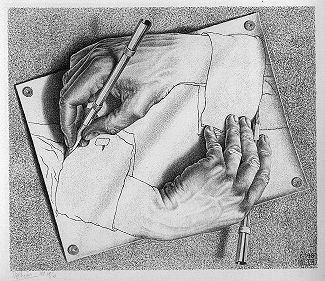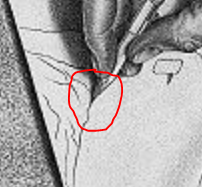This requires serious review! It is just a sketch at the moment.
In particular Affirming the Consequent is only very vaguely analogous. In fact self-reference is set up via logical equivalence.
===
I'm renaming SRH (Self-reference Hypothesis) to Self-Foundation Fallacy(SFF).
SRH which was a place holder since the start of this blog for the intuition that "self" could not fully grasp itself. This is famously formalised by Godel to show that a system with self-reference can also refer to statements that are not provable. In other words self-reference makes a system incomplete. In SRH terms that is to say that the system cannot actually refer to itself in entirety.
In a more general way it forms a Fallacy. Anyone who argues that A proves B so B prove A is he famous fallacy of "affirming the consequent" (ATC). This is common place in argument where someone makes a statement about A and uses it to make a broader statement about B which is either isomorphic with or has A as a subset. Self-reference is rich territory because when someone makes a deduction from A then via self-reference A can also become the consequent. The classic example of this is the Liar Paradox:
A = "I am false"
From A we try and deduce "not A" but we cannot do this because "not A" is founded upon A. The fixed-point from which this is based is:
A = "I"
And we cannot deduce A from A. This is the Self-Foundation Fallacy.
M.C.Escher's famous Drawing Hands (1948)
We know something is wrong. It looks like hand A is being drawn by hand B. That is fair enough assuming we ignore factual things like disembodied hands are dead. The problem arises when we realise that hand B is being drawn by hand A. Why is this a problem? As a work of art it is fine, but we add meaning to this not least that it is a snapshot in time of a continuous verb "drawing." So w realise that going back in time there is a foundation issue here. A is the foundation of B and B is the foundation of A. We don't like that intuitively already, we recognise the SFF.
Going deeper what is the problem. Well the actual foundation are the lines. The picture is "made" from lines. While it looks like the lines are being produced by the hands lets look at one of the two fixed points where hand A has its pen in the sleeve of hand B. The point where the pen meets the line is a fixed point. You have a pen from A at the point of drawing B, which in turn has drawn A. At this point effective A is drawing itself. And that is clearly impossible. In computing terms it never Halts. In logic terms it is a contradiction. We need a pencil to draw the line, but we need the line to draw the pencil.
Obviously we make the Godelian leap here to realise that there are things about this picture that cannot be drawn. And those things are most importantly available in the description: M.C.Escher himself! And also it is not a work in motion it was completed in 1948! We can deduce all this from inside the picture bu realising the fallacy of self-foundation, observing the fixed points, and realising that fixed points imply transcendence to escape self-foundation.
It seems trivial but this fallacy litters the thought and literature space.
Descartes (1637) is one of the most widely known and discussed versions of this: "Cogito, ergo sum." It marks the start of Western Philosophy in some narratives. "I think, therefore I am" is the translation to English.
His path to this reveals its meaning. It was originally the conclusion of a program of doubt. What Descartes asked is certain, and to test this he began to doubt. He doubted all the sense data arguing they could be created by an Evil Demon. This makes its way directly into the modern Matrix (1999) films. Eventually he arrives at the question: can I doubt that I am doubting. He has arrived at the fixed point! This is identical to the Escher's hands. This brings the program to a stop: if there is doubt, then that is a certainty: there is doubt for sure. If there is no doubt, then there is certainty by default. He transcends doubting and Descartes is liberated to a reality beyond doubt. Lets face it don't we don't spend all out time doubting, we know of this doubt free space already! If we don't then what was Descartes doing before he started the program of doubt!
However unfortunately he starts founding things. He decides that in this certainty "I exist." And what is the foundation of this certainty? That he is thinking "I exist." So the awareness of this thought, the knowledge that he is thinking, is the foundation for the thinking itself. Thinking in any form cannot be its own foundation. To turn that into logical fallacy of ATC (above). Descartes is saying that "There are thought" therefore "I exist." But unfortunately what he means by this, by self-reference, is that "I exist" there "there are thoughts". That is Affirming the Consequent. Or in what I'm proposing a more useful form; It's a fallacy according to the SFF because w can see more easily the attempt to present onself as the foundation of oneself.
Now this seemingly trivial feature of self-reference that what looks forward becomes implicitly what goes before is a mistake not just made at the foundation of the West via Descartes but something that sits at the heart of all our lives and philosophy. There is a belief that at the heart of us is a self which is the foundation of everything we do. A homunculus who decides and experiences and lives our life. A something to actually be "me." Buddha warns against such a thought as it is the seed of suffering. But it also suffers from this fallacy. Why do I need a "me" at the heart of my life? Well that is what makes all this mine. And how do I know it is all mine, because of the "me." That "me" unfortunately is the foundation for itself and so via the SFF we can "commit it then to the flames: for it can contain nothing but sophistry and illusion." (to re-appropriate Hume, 1748)
SFF underpins Hegelian and Marxist Dialectics. Given an A we have a local universe U1 composed from A and not-A. However the universe U1 obviously cannot be expressed in terms of either A or not-A. And obvious founding it on A and not-A is a contradiction. U1 also cannot self found via SFF so U1 implies a broader universe U2 in which it can be constructed. The relationship between U1 and U2 is the Godelian incompleteness and is called Aufhebung of Dialectics.



No comments:
Post a Comment